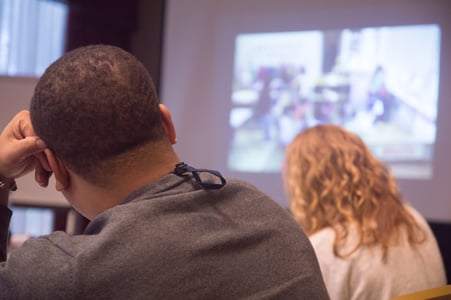
There are videos in CLASS observation trainings that push participants’ “buttons” and challenge their objectivity. You know the ones. Regardless of the age level you are training on, you can usually count on the second video being one of them. Smattered throughout the agenda, there is usually another video that gets under at least one participant’s skin.
Over the years, I’ve become pretty protective of the classroom teachers in those videos. And even though I’ve trained hundreds of people, I’m still surprised at the strong reactions to some of the videos. But I’m much more prepared now than I was during my novice training days to positively facilitate discussions about the challenging training videos.
It’s important for trainers to know that a top reason participants struggle to pass their reliability test is that they are unable to remain objective when coding videos. We have an opportunity during trainings to support participants in becoming more objective observers and coders. But it takes hard work and a little patience on your part. I’m going to share with you a few general strategies I utilize when defending challenging training videos:
- Really know your video. I mean, really, really know it. Here is what can happen during an emotionally charged video: Some participants become so upset that they misinterpret interactions they have viewed or greatly exaggerate something they observed. It will be your job to know this video, so that you are able to provide balance and objectivity. For instance, you can generally anticipate that Pre-K participants will inflate the Negative Climate score in Making Butterflies because of the way the teacher interacts with Ben and Joel. However, if you know the video inside and out, you can note that while these negative moments were certainly unpleasant, that they do not represent the average experience of the average child and are not highly characteristic of the entire segment. If you then ask them to read the low range description of severe negativity on the face page and then turn have them turn to the detailed high range description on page 31, they will understand why they over-coded.
- Utilize a “half-way pause.” I keep an eye on my participants, even as I too am taking notes during the video. I can usually tell that they are getting upset, and in groups who are familiar with each other, they will even start talking. I stop the video at the halfway point and do what I call an “objectivity check-in.”
- Use the “half-way pause” well. I try to keep this conversation as short as possible (not nearly as long as the Video 1 half-way discussion). Start out by acknowledging their emotions and share that remaining objective is crucial to a fair and accurate classroom observation. I willingly share that not remaining objective is a top reason people do not to pass reliability tests. I say, "Here is where I’m going to ask you to trust that the CLASS is going to address your concerns. It will pick up, in an appropriate and objective way, the experience of the average child in this classroom.”
- Start with strengths. Rather than a dimension-by-dimension discussion during this check-in conversation, I say something like, “Okay, let’s just start with some strengths in this video. What interactions/behaviors were effective?” The good news is there are strengths (even if only a few) in the difficult videos. As the participants share what they have observed, you can rephrase those into CLASS language, and tell them where it fits in the tool. For instance, if someone says, “Well, he didn’t get mad at all that crying” then I say, “Good! Yes, the teacher used a calm voice throughout the first half—that fits in Respect for Infant’s State in the dimension Relational Climate” or, “Yes, right, there is a clear absence of irritability or frustration on the teacher’s part, that fits under Lack of Adult Negativity.”
- Next, address the concerns. After strengths, I usually say something like, “I know you have some concerns—let’s talk about those, but just share the facts, rather than the feelings we are having about those interactions.” Now, we talk about the things they didn’t like in the video. I use the same strategy as the “strengths” discussion; they share and I rephrase in CLASS language, and sort as needed. If the participants say something like, “He can’t get that baby to stop crying,” then I say in return, “Right, the teacher’s attempts to soothe the baby are ineffective. That fits under Infant Comfort in the dimension Teacher Sensitivity.”
- Last, I prepare them to return to the video. Now, your participants can return to the video with a new perspective. I take this opportunity to say something like, “Okay, we are going to return to the classroom. Keep that CLASS lens as you observe, rather than a negative lens. Observe the second-half taking factual notes, and when we reach the end, your manual will help you address concerns as well as strengths.”
There you have it, my strategies for making it through those challenging videos. Each trainer has their own strategies and tips for making training video discussions meaningful, so I admit this is my personal story. I’m all about sharing though, and if you have been struggling to maintain order during a difficult video, I hope these tips will support you during your next CLASS training! If you have strategies that work for you, please share them in the comment section below!
